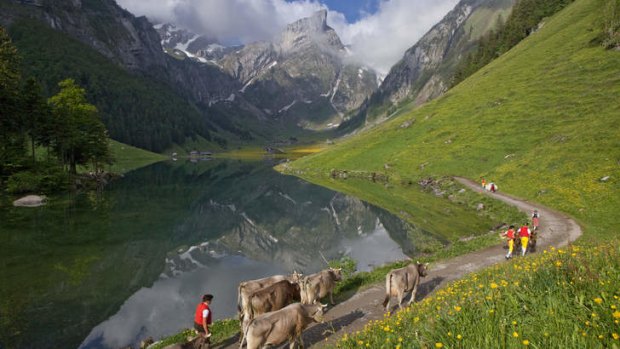
Alpine herdsmen wearing traditional Appenzell costume during a cattle procession to summer pastures at the Seealpsee in Alpstein.Credit: swiss-image.ch/Christof Sondereg
A ritual trek by dairy herdsmen signals change in the alpine seasons, writes Catherine Marshall.
It has been a sumptuous feast but the time for gorging is over. As the last days of summer dust precious sunlight over the Appenzell Alps, herdsmen in the valleys below prepare to collect their Brown Swisses - liquid-eyed, cappuccino-coloured dairy cows - from the mountains where they have grazed away the summer in a cloud of sweet abandon.
The previous evening, a young man emerged from his hut on the mountain and called out to his herd the final, melancholic prayer of summer: "Bless the cows, the people, the alps," he sang. "Keep us safe from hail and lightning, and deliver us from evil spirits."
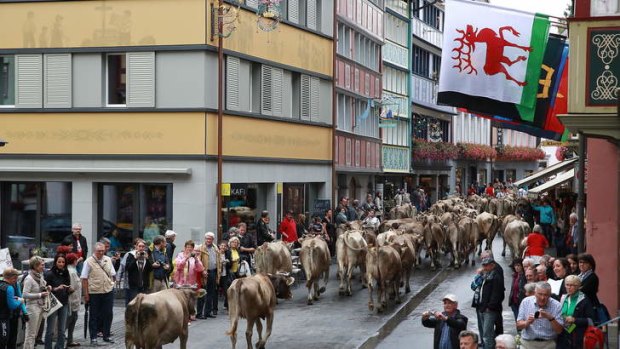
The passage through Appenzell.
Now, as morning breaks, farmer Meinrad Koch gathers with his family and friends in a cafe in the valley. They drink coffee and wine and yodel melodiously in preparation for a centuries-old tradition in which one season is farewelled and another ushered in.
For several weeks in late summer and early spring each year, visitors to Appenzell in Switzerland's north-eastern corner can see such prosaic scenes unfold each day: herdsmen dressed in traditional costumes, their singing resounding across the valleys as they ascend the alps with their cows in spring and guide them safely down again before winter closes in. It is a laborious process, but one that reaps tasty rewards. The cheese produced from the cows' milk fetches a higher price than that of a valley-grazing bovine, for the grass becomes sweeter the higher up it grows and is utterly discernible in the final product.
The herdsmen's yodelling has reached a gentle crescendo now, and fills the cafe with a warmth that might be collected and saved for winter.
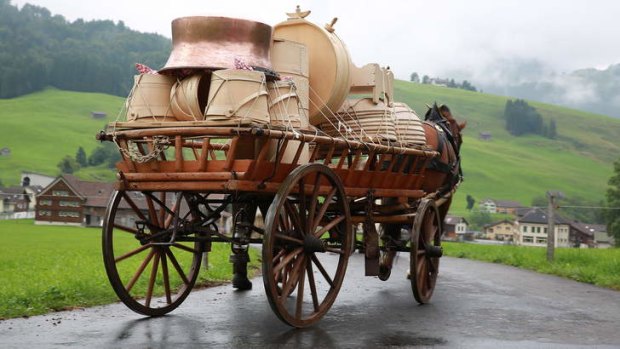
An equipment wagon.Credit: Catherine Marshall
"Nobody puts down notes - it's spontaneous. Someone starts, someone else joins and then everyone else comes in," explains the farmer's son, also named Meinrad.
The young man is dressed in a red waistcoat embossed with intricate embroidery and leather braces studded with brass, story-engraved plates.
A heavy gold earring swings from his right earlobe. Shaped like the spoon used to skim milk during the cheese-making process, it is an heirloom worn by all men and boys on this day.
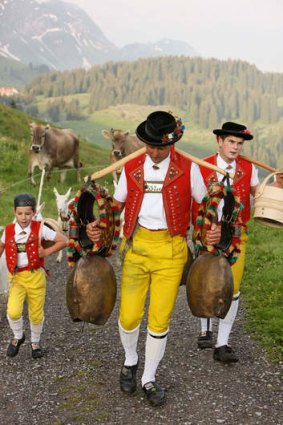
Men and boys lead the cows.Credit: Alamy
"This day is for the men, and it's a really special day for us," Meinrad smiles.
"My grandfather did it, my father did it and now I do it. If you want to live the tradition, then you must spend a lot of time on it."
Their stomachs and spirits fortified, the herdsmen set off on foot into the alps. They take with them a horse-drawn wagon to which traditional dairy implements have been secured: butter urns and milk containers, cheese presses and milking stools made from maple and white pine, and a large copper urn used to heat the milk that will eventually become the cheese.
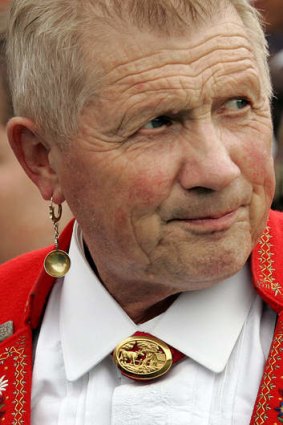
A man wearing an earring shaped like a skimming spoon.Credit: AFP
Up the narrow, winding roads they go, past mountain ashes heavy with bright-orange berries, past mountainside shrines affirming Appenzell's deeply Catholic heritage, past meadows carpeted in grass so thick and voluminous that one might easily drown in it. They cut across sloping pastures now slick with rain and trudge on until finally the mist-swaddled hut comes into view.
There are 35 Brown Swisses grazing on these slopes, but six of them have gone missing overnight. Inside the hut, this inconvenience is momentarily forgotten as Koch's wife, Maria, serves fat farm loaves and a rich porridge, fenz, made from whey, egg, flour, semolina, butter and salt. The herdsmen heap the fenz onto chunks of bread and drink mugs of sweet, fresh milk. Refuelled now for the even more challenging descent, they set off in search of the errant cows.
By early afternoon the jingling of cowbells has heralded the return of the stray Brown Swisses. They rollick towards the hut, happily bloated by the late-summer blades of grass they have managed to extricate from the alps' every last crevice. Behind them, Koch emerges from the mist, walking stick in hand, umbrella deflecting the rain. The cows merge intuitively with their fellows on the rocky mountain path.
A herd of hornless Appenzell goats takes the lead. "They're curious animals and they know where to go," explains Meinrad jnr. Children and youths and cows and wagon fall into place behind them, and farmer Koch brings up the rear. The only creature with free rein is the pure-bred Appenzell mountain dog, which bounces around in wild excitement, racing along the expeditionary party as it begins its long descent.
The mist has gathered tightly now around the alps' elevated slopes, like a landlord come to evict the cows and reclaim these peaks as its own. If it could be swept back, curtain-like, one would see past the haze to valleys opening up below as a concertina would, and houses settled like strewn matchboxes into the foothills' deep creases.
Winter is coming, and the animals have sensed it: the goats set a brisk pace, trotting down the rocky path then turning onto the narrow mountain lane that will faithfully guide them home. The cowbells echo through the ravines and set the rhythm for the herdsmen's spontaneous yodelling.
Down in the villages the people are waiting. They have heard the distant clanging of cowbells and the yodellers' warbled notes and have emerged from their Swiss houses, with sloping eaves, folk art murals and flower boxes, and to line the streets in happy anticipation. Taverners have set out glasses on trays, filled them with red wine and stood outside their establishments, trays aloft, ready to hand to each herdsman a glass filled with sustenance.
Suddenly, they are upon the village, the cacophonous trilling of cowbells and braying of goats and piping of sweet young voices announcing the party's safe arrival. They fly down the hill and into the village's narrow main street.
It has been a short summer - just 10 weeks of alpine grazing - and the descent is now over. From here, this bright caravan continues through the valleys of Appenzell, greeting villagers and sipping wine along the way until they reach their barn in the village of Gonten. It is filled to the beams with straw, enough to keep the cows warm and happy until the snows thaw and they catch the first scent of those sweet spring pastures high in the alps.
The writer was a guest of Switzerland Tourism.
TRIP NOTES
MORE INFORMATION
GETTING THERE
Swiss International Air Lines has a fare to Zurich for about $2090 low season return from Sydney and Melbourne including taxes. Fly to Singapore (about 8hr Singapore Airlines) and then to Zurich (13hr 35min); see swiss.com.
SEE+DO
Ascents take place at the end of May, descents from mid-August to mid-September. Contact Appenzellerland Tourism for more details, phone +41 71 788 96 41, email info@appenzell.ch.
FIVE MORE LIVING CUSTOMS OF APPENZELL
GONTEN BAREFOOT TRAIL
Walk the 5-kilometre barfussweg - barefoot trail - between the Appenzell towns of Gonten and Jakobsbad sans shoes and your feet will thank you. The tactile experience is enhanced by the route's grassy pathways and muddy streams. At the end, you can wash the countryside from your feet in a curative Kneipp bath. See myswitzerland.com.
CULINARY E-BIKE TOUR
Cycle from inn to inn sampling the traditional culinary specialities and majestic views of Appenzell on this 46 kilometre bike tour, which uses electric bikes to propel participants up seldom-used roads. See myswitzerland.com.
SILVESTERCHLAUSEN
Line the streets with locals to watch Silvesterchlausen. The New Year mummer processions are held on December 31 and January 13 and Chlause - characters dressed in fearsome masks, wheel-shaped bonnets and cowbells - pass through villages yodelling, wishing residents well and receiving money and Gluhwein in return. See appenzellerland.ch.
APPENZELLER CHEESEMAKING
A 700-year-old tradition turns the raw milk of herb-and-grass-fed cows into Appenzeller, Switzerland's spiciest cheese. Visitors can make their own version alongside a cheese-maker in a traditional alpine chalet. See myswitzerland.com.
JOKE TRAIL
Familiarise yourself with the unique Appenzeller humour on a trail pegged out with around 80 markers that invite travellers to "smile and tarry awhile". The experience - by foot, mountain train and boat - is especially fun for children. See myswitzerland.com.
Sign up for the Traveller Deals newsletter
Get exclusive travel deals delivered straight to your inbox. Sign up now.